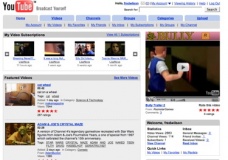YouTube
| Community | Anyone on the web |
| Membership | Anyone with creation of account |
| Privacy | features that support privacy |
| Self Identity | Profile, Videos, Friends, "Likes" |
| Features | Sharing Photos, Comments |
| Status | |
| Launch Date | February 14, 2005 |
| Users | Hundreds of Millions |
Contents
History
YouTube was founded by Chad Hurley, Steve Chen, and Jawed Karim in 2005 to facilitate video sharing. All three were previously employed by PayPal, an online company that acts as a digital wallet for users. YouTube started as an angel-funded enterprise from a makeshift office before receiving a $3.5 million investment from Sequoia Capital in November 2005.[4] Although when the site began, it had little interface, after a receiving this funding, a beta version site was released, quickly followed by a real version. During the summer of 2006, YouTube gained popularity and became one of the fastest growing sites on the Web, with users uploading more than 65,000 new videos per day.[5][6] The site continued to grow rapidly, and was bought by Google in October, 2006 for $1.65 billion[7]. YouTube has gone on to make deals with movie producers as well as television stations in order to display their content on YouTube. Google+ has also adopted YouTube as its video viewing mechanism.
iPhone Application
In 2007, Apple released iOS 6, the first version of iOS to not come with the YouTube application pre-installed. At the time, 25% of all YouTube views were on mobile devices. Apple had announced before the release of iOS 6 that YouTube would no longer be pre-installed, and within a month YouTube had created an app of their own. This caused issues between Apple and Google, as Google was given limited control of the native YouTube application, most notably the control of advertisements - Apple refused to allow YouTube to display ads before videos.[8]
Funding
Similar to Facebook, YouTube is a free website that earns revenue through advertising. Advertisers spend thousands of dollars to have their advertisements featured on top videos. YouTube enforces strict community and technical guidelines for all of its advertisements; the site aims to be fair and consistent with its policies in order to benefit its users, advertisers, and partners. YouTube reserves the right to reject any advertisement from the site that is deemed inappropriate or intrusive, and refunds are not issued for promotions in which the related advertisements disabled, or suspended due to policy violations.[9]
Copyright Concerns
YouTube faces many copyright issues because it does not monitor the content of videos. Section 6-D of YouTube's terms of service states, "You further agree that Content you submit to the Service will not contain third party copyrighted material, or material that is subject to other third party proprietary rights, unless you have permission from the rightful owner of the material or you are otherwise legally entitled to post the material and to grant YouTube all of the license rights granted herein." However, this does not always deter users from uploading copyrighted material. Despite the fact that millions of videos on YouTube are violating copyright, YouTube does not remove the videos, and makes little to no effort to enforce its copyright policies unless a user or company specifically brings an issue to their attention.
Additionally, for the past five years there has been an ongoing lawsuit between YouTube and Viacom. Viacom claimed that YouTube failed to remove copyrighted material, such as "The Daily Show With Jon Stewart" from the site. On April 4, 2012 it was decided that this was a violation of copyright, but the two companies arranged a deal in which YouTube can allow users to rent Viacom's Paramount Pictures movies[10].
Third-Party Claims
Youtube has incorporated a set of content-identifying tools which third-party companies who have a commercial partnership with Youtube can use to search for videos matching their content. This is usually how copyrighted videos are found and removed.
Ethical Issues
Anonymity
It is difficult to control behavior on YouTube, since it is difficult to identify users unless they give out personal information directly. This anonymity means users are often more comfortable using things like YouTube to MP3 Converters, which can be used to download songs from YouTube videos to a user's computer. There are also similar programs which allow users to download videos from the site. [11] Additionally, because it is easy to set up a YouTube account, users that have been banned from the site for violating the terms of service often make new accounts to continue using the site.
Comments
The YouTube comments section has no censorship, which means that there the potential for derogatory or offensive content to be posted. As mentioned above, because YouTube is a mostly anonymous environment, it is difficult for YouTube moderators to track and censor the users who post harmful or offensive material. YouTube does allow users to mark comments as spam, or give them negative votes. If an individual comment is marked as spam, or negatively voted too many times, it does not show up by default and has to be clicked on before viewing.
Benefit
Anonymity can allow YouTube users to contribute to the site more freely without worrying about the release of their personal information, which can allow to more open discussions.
Harm
Anonymity allows users to post content that might be offensive or inappropriate to other users. YouTube administrators can effectively ban an account, but not necessarily a user, since there are no mechanisms in place to prevent a user from creating another YouTube account. In rare cases, if a user's content is strongly incriminating, steps can be taken to identify the user in the real world and seek legal action. For example, in the case of Dusty the Cat, when a Facebook user posted videos of himself abusing an animal anonymously.
ContentID: Piracy and its Prevention
Issues of copyright infringement are prevalent in Youtube videos, copyrighted material is often uploaded without the permission of the owner. To combat this, YouTube has taken steps to insure that copyrighted content is removed, including supplying copyright infringement notifications for third party users.[12]
However, the ContentID system can also cause harm to users who post non-infringing content. For example, bird chirps and motorcycle engines have been known to be identified by the system as copyrighted content on occasion.[13] NASA's public domain broadcasts have also been frequently removed following take-down requests from news services that rebroadcast their material.[14]
See Also
External Links
References
- ↑ Alexa Top Sites | http://www.alexa.com/topsites
- ↑ Youtube | http://en.wikipedia.org/wiki/Youtube
- ↑ Google says one hour of video is now being uploaded to Youtube every second | http://articles.washingtonpost.com/2012-01-30/national/35439542_1_youtube-channels-google-figures-show
- ↑ Woolley, Scott · (2006-03-13) · Raw and Random · Forbes.com · Forbes · 2006-07-28
- ↑ Youtube History
- ↑ lastname, firstname · (July 16, 2006) · YouTube serves up 100 million videos a day online · USA Today · November 29, 2008
- ↑ YouTube CrunchBase
- ↑ YouTube releases new iPhone app
- ↑ YouTube Advertising Policies
- ↑ http://topics.nytimes.com/top/news/business/companies/youtube/index.html
- ↑ http://www.youtube-mp3.org/
- ↑ http://www.youtube.com/t/copyright_center
- ↑ http://thenextweb.com/google/2012/02/27/a-copyright-claim-on-chirping-birds-highlights-the-flaws-of-youtubes-automated-system/
- ↑ http://www.techdirt.com/articles/20120806/11053019945/curiositys-mars-landing-video-disappears-youtube-due-to-bogus-copyright-claim.shtml
| ←Back • ↑Top of Page |


